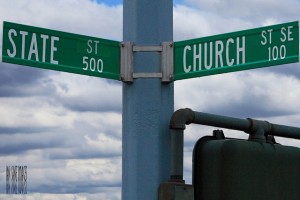27 Jun Third Circuit: Establishment-Clause Challenge To Existing Display Not Time-Barred
Bible Baptist Church Welcomes You! 1 Block –>
So reads the sign—decorated with a gold cross and white Bible—that the Borough of Shickshinny, Pennsylvania, allowed to be placed on its right-of-way.
A nearby resident, Francene Tearpock-Martini, objected. She sued the Borough under 42 U.S.C. § 1983, alleging that the sign violates the Establishment Clause.
Tearpock-Martini’s lawsuit had a problem though.
Tearpock-Martini had commenced the suit more than two years after the church sign was installed. Under Pennsylvania law, tort actions generally must be brought within two years. And 1983 actions often borrow the statute of limitations from state law.
Is her suit time-barred? In a decision this week, the Third Circuit said that it is not:
[T]he traditional rationales justifying a limitations period—”to protect defendants against stale or unduly delayed claims,” “facilitat[e] the administration of claims,” and “promot[e] judicial efficiency,” John R. Sand & Gravel Co. v. United States, 552 U.S. 130, 133 (2008)—simply have no persuasive force in this context. Tearpock-Martini’s challenge is to a still-existing monument that communicates anew an allegedly unconstitutional endorsement of religion by the government each time it is viewed. Strict application of the statutory limitations period both serves no salutary purpose and threatens to immunize indefinitely the presence of an allegedly unconstitutional display.
The court stated that it was not aware of any opinion holding that an alleged Establishment-Clause violation predicated on a still-existing display or practice was time-barred.
Image courtesty of Flickr by Ian Sane (creative-commons license, no changes made).



